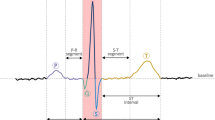Abstract
Considerable research effort has been devoted to the estimation of the degree of organisation of atrial fibrillation (AF), to potentially support clinical decision making. The aims of this study were to: (1) analyse the temporal variability of spatial organisation (complexity) and spectral distribution of AF in body surface potential maps (BSPM), proposing an automated implementation of the analysis and (2) assess the applicability to reduced lead-sets. Twenty-one persistent AF recordings of 3 min each (64 BSPM: 32 anterior, 32 posterior) were analysed. The relationship between spatial organisation (C) and its variability (CV) was quantified on automatically delineated TQ segments. The relationship between spectral concentration (SC) and spectral variability (SV) was quantified on the atrial activity (AA) extracted using principal component analysis. Three different lead-sets: 64, 32 anterior and 10 anterior channels were considered. Significant (p < 0.001) correlation (ρ) was found: ρ(CV, C) ≥0.80, ρ(SC, SV) ≤−0.83 for all lead-sets. The results suggest that a higher degree of spatial organisation is associated with reduced variability of spatial organisation over time, and lower spectral variability associated with more prominent spectral peak in the AF frequency band (4–10 Hz).





Similar content being viewed by others
References
Alcaraz R, Rieta JJ (2009) Surface ECG organization analysis to predict paroxysmal atrial fibrillation termination. Comput Biol Med 39:697–706
Alcaraz R, Rieta JJ (2010) The application of nonlinear metrics to assess organization differences in short recordings of paroxysmal and persistent atrial fibrillation. Physiol Meas 31:115–130
Asano Y, Saito J, Matsumoto K, Kaneko K, Yamamoto T, Uchida M (1992) On the mechanism of termination and perpetuation of atrial fibrillation. Am J Cardiol 69:1033–1038
Bollmann A, Husser D, Mainardi L, Lombardi F, Langley P, Murray A, Rieta JJ, Millet J, Olsson B, Stridh M, Sörnmo L (2006) Analysis of surface electrocardiograms in atrial fibrillation: techniques, reseach, and clinical applications. Europace 8:911–926
Bonizzi P, de la Salud Guillem M, Climent AM, Millet J, Zarzoso V, Castells F, Meste O (2010) Noninvasive assessment of the complexity and stationarity of the atrial wavefront patterns during atrial fibrillation. IEEE Trans Bomed Eng 57:2147–2157
Castells F, Rieta JJ, Millet J, Zarzoso V (2010) Spatiotemporal blind source separation approach to atrial activity estimation in atrial tachyarrhythmias. IEEE Trans Bomed Eng 52:258–267
Censi F, Barbaro V, Bartolini P, Calcagnini G, Michelucci A, Gensini GF, Cerutti S (2000) Recurrent patterns of atrial depolarization during atrial fibrillation assessed by recurrence plot quantification. Ann Biomed Eng 28:61–70
Di Marco LY, Chiari L (2011) A wavelet-based ECG delineation algorithm for 32-bit integer online processing. Biomed Eng Online 10:23
Faes L, Nollo G, Kirchher M, Olivetti E, Gaita F, Riccardi R, Antolini R (2001) Principal component analysis and cluster analysis for measuring the local organisation of human atrial fibrillation. Med Biol Eng Comput 39:656–663
Gerstenfeld EP, Sahakian AV, Swiryn S (1992) Evidence for transient linking of atrial excitation during atrial fibrillation in humans. Circulation 86:375–382
Konings KT, Kirchhof CJ, Smeets JR, Wellens HJ, Penn OC, Allessie MA (1994) High-density mapping of electrically induced atrial fibrillation in humans. Circulation 89:1665–1680
Langley P, Rieta JJ, Stridh M, Millet-Roig J, Sörnmo L, Murray A (2006) Comparison of atrial signal extraction algorithms in 12-lead ECGs with atrial fibrillation. IEEE Trans Bomed Eng 53:343–346
Moe GK, Abildskov JA (1959) Atrial fibrillation as a self-sustaining arrhythmia independent of focal discharge. Am Heart J 58:59–70
Moe GK, Rheinboldt WC, Abildskov JA (1964) A computer model of atrial fibrillation. Am Heart J 67:200–220
Raine D, Langley P, Murray A, Dunuwille A, Bourke JP (2004) Surface atrial frequency analysis in patients with atrial fibrillation: A tool for evaluating the effects of intervention. J Cardiovasc Electrophysiol 15:1021–1026
Raine D, Langley P, Murray A, Furniss SS, Bourke JP (2005) Surface atrial frequency analysis in patients with atrial fibrillation: assessing the anti-arrhythmic effects of linear atrial lesions. J Cardiovasc Electrophysiol 16:838–844
Richter U, Faes L, Cristoforetti A, Masè M, Ravelli F, Stridh M, Sörnmo L (2011) A novel approach to propagation pattern analysis in intracardiac atrial fibrillation signals. Ann Biomed Eng 39:310–323
Sih HJ, Zipes DP, Barbari EJ, Olgin JE (1999) A high-temporal resolution algorithm for quantifying organization during atrial fibrillation. IEEE Trans Bomed Eng 46:440–450
Wijffels MC, Kirchhof CJ, Donald R, Allessie MA (1995) Atrial fibrillation begets atrial fibrillation: a study in awake chronically instrumented goats. Circulation 92:1954–1968
Acknowledgments
The authors would like to thank Susan King at the Regional Medical Physics Department, Freeman Hospital, Newcastle upon Tyne, UK, for data collection.
Conflict of interest
The authors declare that there are no conflicts of interest, financial or otherwise, related to this work.
Author information
Authors and Affiliations
Corresponding author
Rights and permissions
About this article
Cite this article
Di Marco, L.Y., Bourke, J.P. & Langley, P. Spatial complexity and spectral distribution variability of atrial activity in surface ECG recordings of atrial fibrillation. Med Biol Eng Comput 50, 439–446 (2012). https://doi.org/10.1007/s11517-012-0878-8
Received:
Accepted:
Published:
Issue Date:
DOI: https://doi.org/10.1007/s11517-012-0878-8




